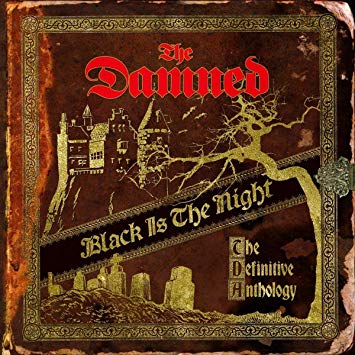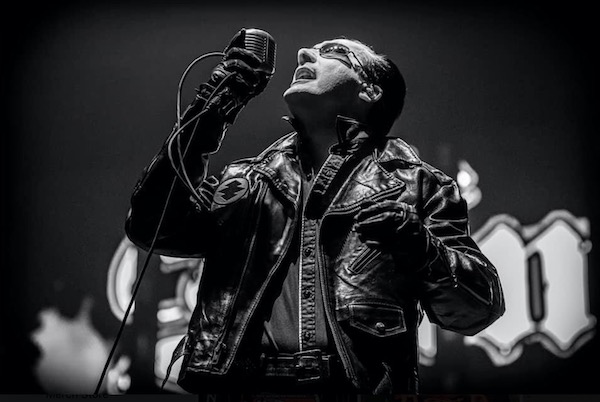Rock CD Review: The First Punk Rockers? The Damned Release “Black Is The Night”
By Matt Hanson
Melody is one of the things that keeps a song from floundering, no matter how in-your-face its rhythm and chord structure might be, which is something a lot of spunky punk bands tend to forget. The Damned always kept that well in mind.

Like almost all vital musical genres, it’s not really all that important to pinpoint exactly when and where punk rock really started. The usual story goes on about “Sex Pistols this” and “Ramones that” or speculates whether Iggy Pop or Lou Reed deserves the “godfather of punk” designation. Some might push it a little farther back and argue that it’s the brilliant but doomed Eddie Cochran who deserves to have the ceremonial patch sewn on to his funeral shroud. Lester Bangs, a true connoisseur, once semi-jokingly traced it back to rabble rousers like the Marquis De Sade and Voltaire. But, if we’re talking about the band to whom the distinction “punk” was first officially applied, it would have to be The Damned, who have a nifty new career-spanning anthology spread out over two packed discs entitled Black Is the Night.
The Damned worked their punk rock black magic more or less by historical coincidence rather than by explicit intent, releasing their still-fun debut Damned Damned Damned at the same time as the Pistols and The Clash. Their first album proffers plenty of wild, just-don’t-give-a-damn energy that’s fired off via the iconic “New Rose” and continues rollicking through a song list that sounds pretty much exactly the way the cover shot looks — an epic food fight with each member spattered with cake goo, grinning fiendishly behind thick shades.
Nobody thought, as their whimsically monikered axeman Captain Sensible once explained, that they’d ever get another shot at making another record, so why not go for broke? As the highly entertaining documentary Don’t You Wish That We Were Dead demonstrates, the past several decades have proved that this wasn’t the case. The booklet unfolds with a photo spread chock full of the memorabilia from shows and records past and also traces a punk family tree of sorts, following the many different bands who were started by ex-members.
After giving Black Is the Night a few spins, it’s increasingly clear how diverse their sound really was. Most other punk bands tended to make a couple of really good records and then flame out. Longevity isn’t necessarily a punk trait. Some of the punk bands who became great in their own right (like, say, The Clash, Black Flag, and Patti Smith) ultimately transcended easy categorization. Looking over The Damned’s corpus it’s easy to see how the band’s sound nimbly evolved over time. Singer (and former gravedigger) Dave Vanian dressed like Dracula and borrowed a bit of the elegant bloodsucker’s doomy vibe, but he also applied himself to writing increasingly complex tunes over the years. The anthology is arranged more like a mix tape than a straight chronology, so it keeps the tempo up over material that spans decades.
From the early days, there’s “New Rose” and the giddy “Neat Neat Neat” (recently featured as ideal getaway driving music in the film Baby Driver) along with the often-covered “Smash It Up.” The Damned were forebears of pop-punk, with insouciance to burn. But as the years passed, there’s a distinct sea change in subject matter and sonic texture that speaks well of their ability to innovate while staying true to the punk vibe. In “Plan 9 Channel 7” there’s a fairly nuanced, Sunset Boulevard-esque story line amid the driving beat and whooping half-harmonies: “She lays a wreath of lilies on his grave/ His flame gone along with the love he never gave/ Not to be seduced by those two red lips/ Two dimensional comic clips/ Hollywood babbles on and on on.”
“Melody Lee” opens with a mournful solo piano that suddenly gives way to a head-bobbing pop-punk riffing that had to have been on constant rotation for those who would later form bands that built on a combination of introspection and energy like, say, The Descendants. Ditto for “The History of the World Part 1” and “I Just Can’t Be Happy Today,” both of which pair melodies you can bellow along with and satirical swipes on a world gone mad. A couple of somewhat surprising covers, Jefferson Airplane’s “White Rabbit” and Love’s “Alone Again Or,” are handled with the right amount of cheek and appreciation for a killer melody. Melody is one of the things that keeps a song from floundering, no matter how in-your-face its rhythm and chord structure might be, which is something a lot of spunky punk bands tend to forget. The Damned always kept that well in mind.

Dave Vanian and The Damned release Black Is the Night, The Definitive Anthology. Photo: Wes Orshoski.
Interestingly, along with Vanian’s penchant for vampire garb, The Damned also might be a crucial forerunner for goth rock. Phantasmagoria, one of their ’80s records, featured a black-clad, exquisitely witchy cover girl who went on to become the wife of Nick Cave, as truly gothic a singer/songwriter as we’ve got. One of the band’s biggest hits, the sprightly but eldritch “Grimly Fiendish,” is a Halloween outfit in musical form. “Dr Jekyll and Mr Hyde” gives a tip of the black fedora to one of the essential tales from the darker side of the library. “Wait for the Blackout” celebrates the nocturnal lifestyle as a welcome romantic relief from a sunshiny world where “the light here is too bright.” And then there’s the epic, ambient, experimental “Curtain Call,” where Vanian sounds as if he’s sitting at the bottom of the ocean, intoning over a series of musical variations and sound effects. The attention of an ADD-afflicted listener might wander, but the song consistently changes shape enough times to keep things interesting for most of us.
Not many other bands who came up playing grungy London clubs to sweaty crowds pogoing into each other wanted to venture this far afield from the “three chords and the truth” minimalist punk ethos. And, in the end, that willingness to go out on a musical limb and then bounce up and down is what sets The Damned apart from most bands of their generation. Why should a group who helped jump-start the punk revolution rest on its laurels? Or be content to grow stale through repetition? Maybe the most punk thing a band can do is to be ever ready to get dark and freaky — but never hesitate to rave it up when the mood strikes. It’s true that there have been plenty of compilations, discs of rarities, and such over the years, but this anthology is designated as “definitive” and, since it contains decades of material, it’s safe to say the tag is probably correct. For longtime fans, Black Is the Night might not be a must-buy. But for those who haven’t heard The Damned in depth (who might be a majority) it offers a handy case study, maybe even a definitive one, in how it’s done.
Matt Hanson is a contributing editor at The Arts Fuse whose work has also appeared in The American Interest, The Baffler, The Guardian, The Millions, The New Yorker, The Smart Set, and elsewhere. A longtime resident of Boston, he now lives in New Orleans.
